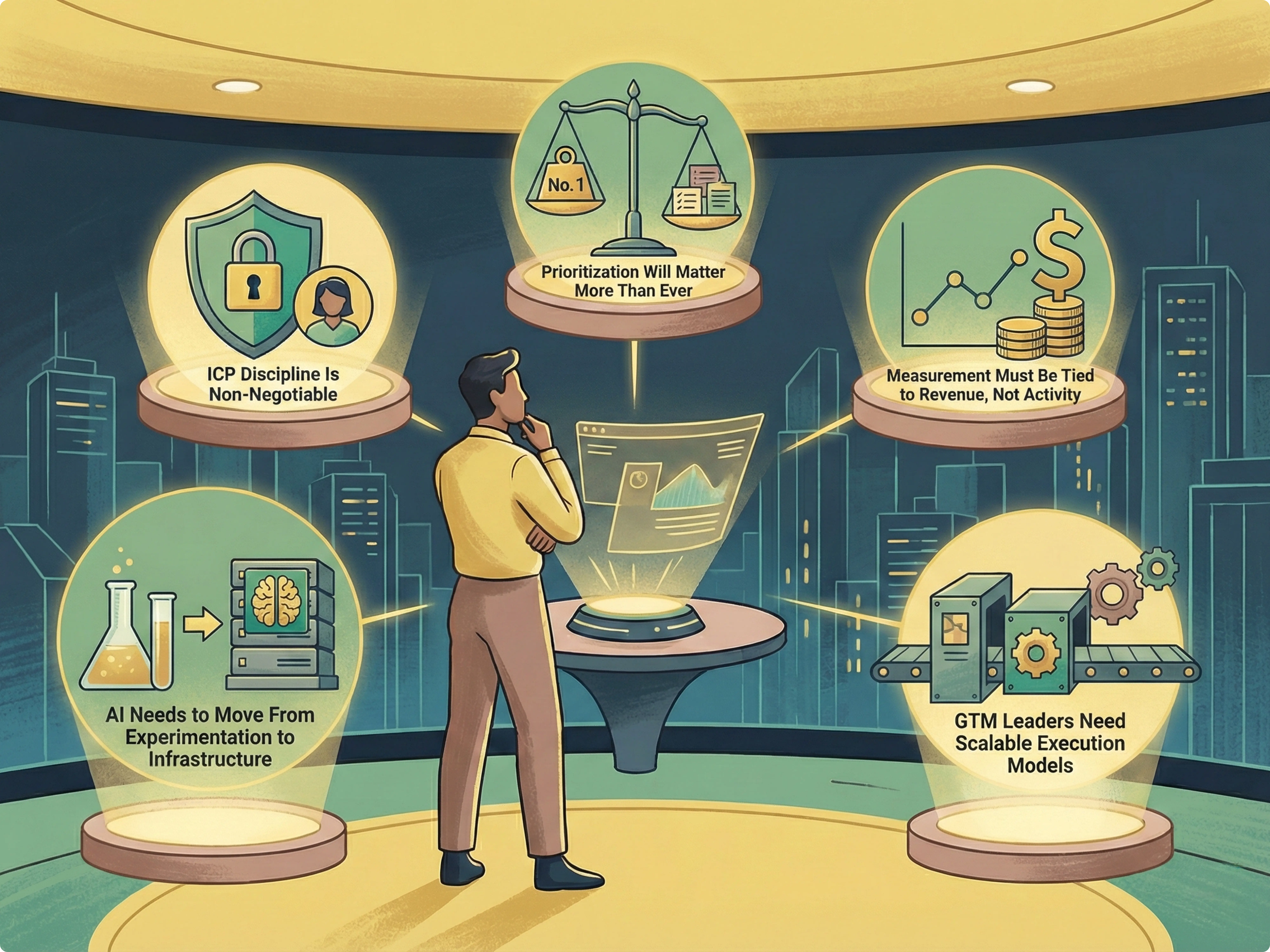The typical notion of marketing assumes a simple path. A consumer feels a need, searches for a solution, immediately finds and clicks your ad, and converts. But that’s only the tip of the funnel. The visible part. What actually drives acquisition happens long before that click ever occurs.
Before anyone lands on your site, they’ve been silently researching, comparing, asking around, and forming opinions. They’re reading forums, scanning reviews, lurking in comment sections, and watching how your brand (and your competitors) show up when no one’s actively selling.
This is the hidden part of the iceberg funnel, and optimizing for it can help you earn trust earlier and position your brand as the natural choice when users are finally ready to act.
Let’s see how the iceberg concept works and how you can maximize it.
#mc_embed_signup{background:#fff; false;clear:left; font:14px Helvetica,Arial,sans-serif; width: 600px;}
/* Add your own Mailchimp form style overrides in your site stylesheet or in this style block.
We recommend moving this block and the preceding CSS link to the HEAD of your HTML file. */
Sign Up for The Start Newsletter
(function($) {window.fnames = new Array(); window.ftypes = new Array();fnames[0]=’EMAIL’;ftypes[0]=’email’;fnames[1]=’FNAME’;ftypes[1]=’text’;fnames[2]=’LNAME’;ftypes[2]=’text’;fnames[3]=’ADDRESS’;ftypes[3]=’address’;fnames[4]=’PHONE’;ftypes[4]=’phone’;fnames[5]=’MMERGE5′;ftypes[5]=’text’;}(jQuery));var $mcj = jQuery.noConflict(true);
The iceberg funnel concept in marketing
The iceberg funnel is a marketing and sales metaphor used to describe how only a small portion of user actions and surface metrics are visible, while the majority of their behavior before taking those actions remains hidden behind the scenes.
Visible: Website visits, clicks, ad conversions, sign-ups. Usually the measurable stuff
Hidden: Forums, friends, family, social media, communities, blog posts, brand mentions. Every action before the user directly interacts with your brand
For instance, Skyle, a 22-year-old college student, is in huge credit card debt.
Late at night, she’s scrolling Reddit threads on student finance, reading anonymous stories, surfing Quora for advice, and watching YouTube videos about “how she can bypass, reduce, or scale her debt.”
This is where acquisition begins.
Right now, she’s not checking out ads from brands positioning themselves as debt solution providers
She might not even be aware that such solutions exist
Skyle only needs valuable information, possibly even free solutions
And she expects you to show up.
Stanislav Khilobochenko, VP of Customer Services at Clario, says, “Unsurprisingly, most marketers take a back seat here. Some set a lead trap—where you simply wait for a lead to click before going full thrust into the conversion process. You don’t care about what she has done before so long as she ends up in your funnel.”
“The disadvantage of this is that you’re not the only one setting up these so-called lead traps. It’s a competition of who has the most ad budget and can achieve the greatest reach. In the end, out of a hundred leads, you might end up with only two or less than a dozen, or maybe nothing,” Stanislav adds.
Smart brands, on the other hand, win Skyle’s trust even before she’s ready, or while the funnel is still submerged.
They show up with honest answers, useful content on debt relief programs, and empathy, not aesthetic banners, on online communities.
They contribute to forum questions about budgeting and financial management on Quora and Reddit.
This continues until she’s ready to make a decision. And by then, she’s likely to lean towards the name that helped even when she wasn’t looking to “pay.”
Victor Iryniuk, Communication Manager for NetHunt CRM, answers Quora questions
SalesForce
AI + Data + CRM = more sales and happier customers.
Start or grow your business with the #1 CRM. Salesforce now has AI tools that helps you connect with your customers in a whole new way.

The hidden part of every iceberg funnel
In the iceberg concept, only 10-20% of your funnel is visible. The remaining 80-90% is hidden and often untapped. Let’s divide the hidden funnel into four sections to understand better:
Pre-click awareness phase
This is where people realize they have a problem, start researching the severity of the issue, and seek out others who face similar challenges. They ask their friends and family and go to social media platforms to discuss their needs. These actions subtly remain at the base level of your iceberg funnel.
Indirect Influences
Here, they start looking for solutions through peer recommendations and engaging in community discussions. At some point, they may come across your brand multiple times, perhaps on search engines, social media, or through a reference by ChatGPT, and this gradually shapes their perception.
Untracked touchpoints
Your potential customers sift through reviews, YouTube videos, external blog posts mentioning your brand, online forums, product comparisons, and testimonials. These touchpoints are outside your tracking capacity, and that makes it difficult to leverage them effectively.
Conversion readiness
After multiple untracked exposures and subtle trust-building moments, they are finally ready to engage. They’ve formed a mental list of suitable solutions, containing you and a few other competitors if you’re lucky. Their final decision to click or not hinges on several factors, but the vital one involves the relationship they’ve formed with your brand. If none, you’re likely out.
Zoho CRM
Bring the very best out of your customer-facing teams with robust automation, comprehensive analytics, personalized solutions, and more. Sign up and get started in no time—the fastest implementation in the enterprise CRM market.

Why does the hidden funnel matter for acquisition?
Just as we explained before, most of the decision-making process for every user is subconscious. Your ideal customer is going silo with their research and desperately looking for solutions. They end up exploring several options along the way, and their decision-making process becomes even more complicated.
When you step in at this moment, you become their knight in shiny armor. Even before they reach the buying stage of a typical marketing funnel, your brand floats at the top of their mind, and they’ve made a decision already. When the need arises, they find it easier to choose you over competitors.
At a glance, if you take advantage of the whole funnel, you’ll be able to:
Influence buying decisions before users actively shop
Build trust while competitors are still chasing clicks
Stay top-of-mind when it’s finally time to choose
And if you don’t, you’ll have to:
Compete on ad spend instead of trust
Fight for attention when the decision is already made
Settle for scraps in a crowded, late-stage funnel
Monday.com CRM
Streamline your operations with one tool
Manage your entire sales cycle, track client communication, and connect your projects, marketing activities and much more with a CRM that’s easy to use.

6 ways to maximize your funnel
Most marketers and sales teams optimize their funnel post-click. What you’re doing is the reverse. You start right from the submerged part of the funnel—the moment your audience has a problem, and even before they start looking for solutions or click.
Map real search intent, not just keywords
Chasing high-volume keywords without context is a losing game. Instead, find the why behind each query. Are they confused, just browsing, or ready to take action? To do that, you need to start with exploring first, not SEO tools.
Hang out on Reddit, Quora, niche Facebook groups, Twitter threads, and forums where your target audience congregates. Look for how people talk about their problems. Pay attention to emotion, confusion, and phrasing. Those are signals for intent. Tailor your content and keywords to address them.
You should also conduct competitor analysis to identify ways in which other sites are targeting customers and what search engines are deeming to be most applicable to the search intent of each query. Then, modify your content front with your research insights.
Embed your brand in communities that matter
According to a study conducted by GWI, the number of internet users participating in online communities increased from 72% to 76% between 2017 and 2019. The figure has surely grown higher, indicating that people are more comfortable sharing personal things online and forming authentic connections.
This also means your potential customers will be there to share problems, complain about a product or service, request help, and so on. When you show up with relevant answers at this stage, your acquisition process is half done.
To do that, find public and private online groups your audience is more likely to be on and join. For instance, early-stage SaaS founders may be active in communities such as Indie Hackers, the SaaS Growth Hacks Facebook group, or niche Slack channels like Traffic Think Tank or RevGenius.
Network, answer questions, provide solutions, and offer valuable guidance to establish yourself as an authority. No need to pitch at this stage, at least until you’re seen as a reliable source. By the side, your profile should talk about your product or brand—that’s enough cue for them to know what you do.
Over time, you can gradually blend each guide with a pitch.
Mine forums and reviews for user data and contribution
Just like groups, forums are a ground to mine user behavior, position your brand as a guide, and be as useful as possible to your audience. The most important is user behavior and intent. With typical audience research, you’ll only scratch the surface, getting demographics, roles, or interests.
But in forums, you see what they actually say, what they struggle with, how they ask for help, and what solutions they trust. You can use this insight to optimize your campaigns and content, while also contributing to these forums to ensure our brand stays at the top of their minds.
Popular examples of forums to leverage include Reddit threads, Quora, and Stack Overflow, which are particularly useful for developers.
Review sites are also magic. They often contain users’ unfiltered concerns and worries. So, look up your competitors on review platforms like G2, Capterra, or industry-specific review sites and see what perplexes their audiences.
Build content for each stage of the iceberg funnel
The iceberg funnel is not synonymous with the typical marketing funnel, but they work hand in hand. Top of the funnel (TOFU) and Middle of the funnel (MOFU) address the submerged part of your iceberg funnel, whereas Bottom of the funnel (BOFU) focuses on the visible aspect.
You should ensure to build content for each stage, especially for the TOFU stage. TOFU educates and informs, which is perfect for guiding your audience when they need instructional and suggestive guidance.
To maximize content visibility, share excerpts of these posts on your forums, groups, online communities, and social feeds.
Leverage GEO for extra visibility
A few years ago, Google and Bing were the go-to options for finding answers. However, that has changed since the emergence of ChatGPT. As of Q1 in 2025, ChatGPT had over 367 million users and more than 5.2 billion monthly visits. A significant portion of these visits involves queries about why, how, when, and where.
Source
The best part is that some of these generative tools now have direct internet access. So, when users ask questions like, “What is the most suitable B2B software to use?”, it comes with a real-time list of suitable brands or solutions. And this is part of the hidden iceberg funnel, the untracked touchpoints.
Now imagine being able to slot your brand into that list and appear whenever a user is looking for answers or solutions.
Not just for tool recommendations. ChatGPT now provides references to source websites when asked a question. Users can click these references to visit the website and confirm more details directly. So, if your website ends up becoming a reference, that’s traffic and leads for you.
The process of positioning your brand for these AI tools is called Generative Engine Optimization (GEO). To do it:
Publish authoritative, helpful content that answers specific, high-intent questions clearly and concisely
Structure your content semantically using proper headings, bullet points, and schema markup to help AI understand it
Use natural language that mimics how users ask questions, not just keyword-stuffed phrases
Cite credible sources and link out when relevant, increasing your chances of being seen as a trustworthy reference
Lastly, monitor how your content appears in AI-generated answers and update it regularly to stay relevant and visible.
Verizon Small Business Digital Ready
Find free courses, mentorship, networking and grants created just for small businesses.

Wrapping up
90% of acquisitions occur before consumers click. They’ve made up their mind on which brand to purchase from. That means brands focusing on post-click before turning their conversion wheel risk missing out. If you take advantage of the hidden funnel, you end up becoming your potential customers’ first go-to.
To do that, map real search intent, not just keywords. Embed your brand in communities, network, interact, and provide helpful solutions. Position yourself as a guide, not a pitch, on forums like Quora and Reddit.
Leverage review sites to see what consumers think about your competitors. The insights will help you tailor your campaign to target leads in the submerged funnel. Build content for every stage of your marketing, especially TOFU. Lastly, utilize GEO to capture a share of GenAI traffic and leads.
Image by freepik
The post The Iceberg Funnel: Why 90% of Acquisitions Happen before the Click appeared first on StartupNation.




















